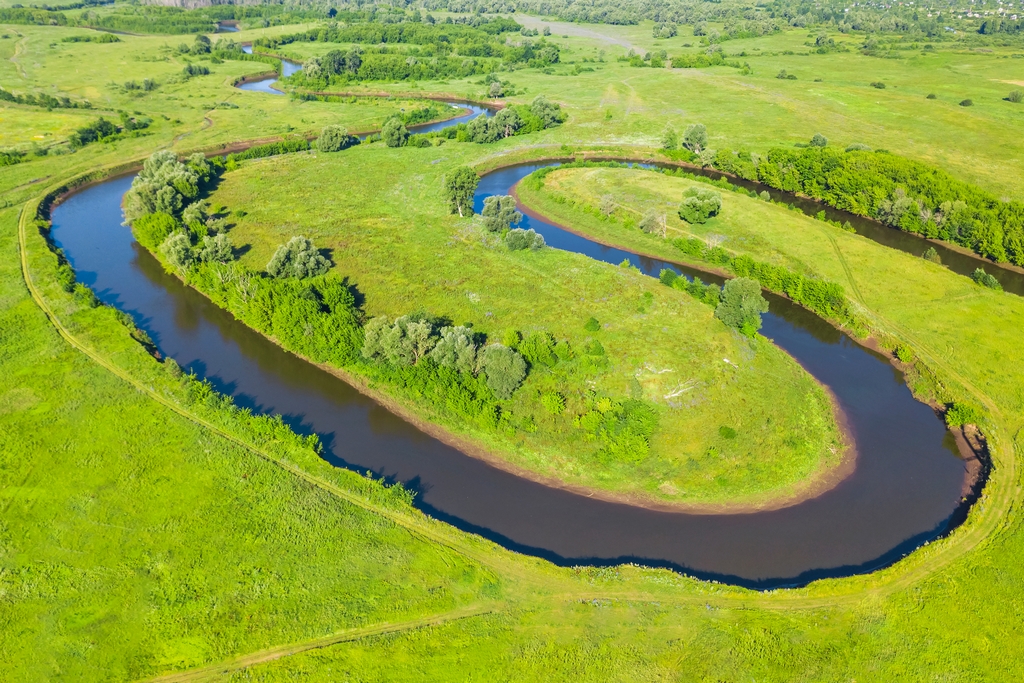Why Rivers Bend


Have you ever wondered why rivers almost always form snake-like forms as they move downslope toward their destinations? The underlying science is both sublime in concept and profound in its implications, stretching from how the Grand Canyon was formed to the way energy is disbursed as water flows through pipes.
By Eric Herman
For years I’ve been fascinated by the “shape” of rivers. From high above, it’s striking to see how nearly all rivers, regardless of their geological setting or size, meander in similar paths through the landscape.
This self-evident tendency has tremendous impact on the land and the way people settle along rivers. The snaking course of the Mississippi is why New Orleans is nicknamed Crescent City, because of the way it hugs the winding banks of the mighty river. The contours impact the location of ports, bridges and even the size of ships and barges.
River bends often form beaches and wetlands that in turn support vast biodiversity. And, more than anything, they carve the landscape, sometimes to tremendous effect – think the winding channel at the bottom of the Grand Canyon carved by the Colorado River.
While it is easy to recognize and marvel at the serpentine nature of rivers, it still begs the question why? As it turns out, the reason that rivers bend has much to do with why water itself can be such a difficult substance manage and contain, and many ways why it’s such a dynamic force. There is an abundance of explanations in scientific literature and online these days, and they all point the same set of facts and processes.
A condensed explanation goes something like this: The bends, or meanders, in rivers exist to manage the energy water carries with it as it moves through the land. By increasing the resistance and reducing the “channel gradient,” as the river turns, the geometry of the river course minimizes the amount of energy expended.
As described in an essay by the Aussable River Association, “Streams meander to maintain equilibrium – a dynamically stable form and function. The bends are created when water flowing down the river channel erodes sediments on the outer bend of the river banks and then deposits it on the banks of the inner stream downstream.”
That’s simple enough, but things do get a bit more complex when considering the physics of moving water. According to Theodor Schwenk, a pioneering German industrialist and author of the seminal book The Sensitive Chaos, water always seeks to form a sphere, which creates a level of constant oscillation as the sphere is constantly disrupted by the flow and the material it is flowing through.
Schwenk writes: “Its endeavor to complete the sphere is only partially successful, as it cannot flow back up hill to its starting point. Right at the beginning of its circulatory movement it is drawn downhill and following this downward pull, it swings alternately side to side. The direction of this revolving movement results from the fact that the water on the surface flows from the inside of the bend to the outside. There it turns downwards and returns along the bed of the stream to the inner bank, where it rises again to the surface.
“The two movements together, the revolving circulation as the movement downstream results in a spiraling motion. Because of this process, the river eats its way further and further outwards at the outer bank, swinging side to side as it flows, thus making the loops more and more pronounced.”
(As an aside, according to Schwenk, this is also why the veins in leaf, the capillaries in your eyeballs and countless other natural forms follow the same patterns. Plants and animals are all made primarily of water and subject to the same physical properties as the land itself.)
In systems where the structures containing water are not easily eroded and the flow seemingly straight, the same oscillations are observed with the internal water flow. According to Schwenk, “In straight pipes, too, especially those with angular cross sections, internal movements come about that are similar to the meanders where one would first assume that the water would flow straight ahead. Separate small secondary circulatory systems fill the cross-section of the pipe and together with the main flow forward create moving, spiraling surfaces.”
This is all why moving water eternally asserts its will on the structures that seek to contain it. In short, it is why rivers bend, and how water shapes our world.
Image attribution: Photo by Anton Watman, Shutterstock









